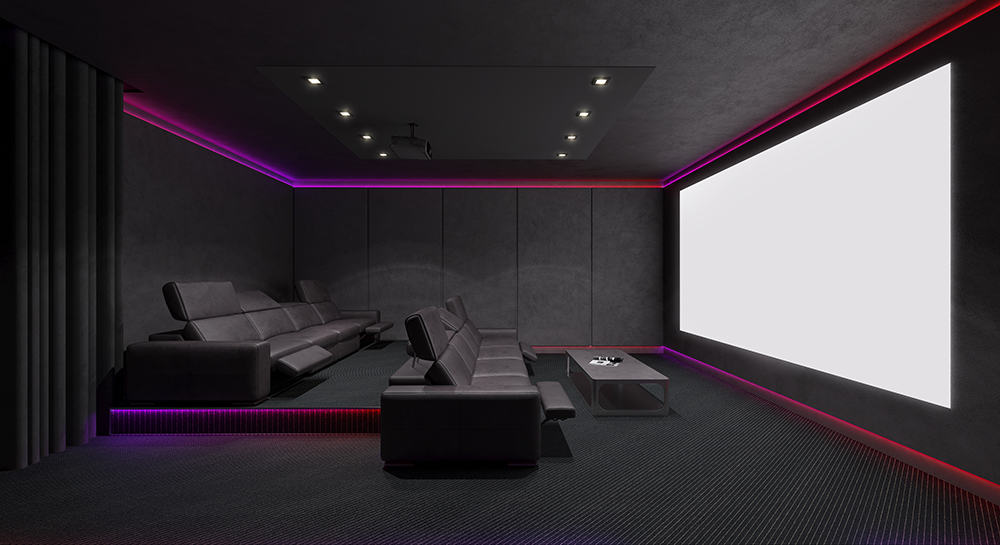Projector screens are large. Some are huge. So big, in fact, that up until a few short years ago, this article would have been much briefer. It would have read ' buy a big projector screen, it is cheaper and the picture quality is far better'
However, technological advancement for TVs has increased with such vigor in recent years that the TV vs Projector debate is a point of contention.
TV screens are getting bigger as their costs seem to decrease.
With that said, there is no definitive answer, it is a personal choice, settled upon after considering several criteria.
The chosen room and its size, positioning of the screen, and its main uses are the initial considerations.
Not to forget the big two – lighting conditions and budget.
Television screens might be getting ever-increasingly larger, but few can rival the size of a projection screen. Undoubtedly, the most realistic way to emulate the 'going to the movies' experience is viewing from the largest possible screen. But at what cost?
Most projection screens surpass the 100-inch measurement and, as the image enlarges, it is right to be concerned that the definition might somewhat degrade.

Simply put, resolution pertains to the quality and sharpness of an image, and how it maintains fine detail as it becomes enlarged.
Televisions with 4K can enlarge images more than 1080p projectors can, before losing finite detail.
Resolution directly correlates with screen size and viewing distance; watching a 4K screen from a greater than recommended distance is pointless. The viewer sees all images in 1080p once out of 4K range, preventing them from appreciating the added clarity and resolution that 4K provides.
A projector easily projects larger images at greater distances. For example, the resolution doesn't degrade from the 10-feet away or the back of a large room. Images remain in 1080p.
There are also 4K projectors available, however they are expensive.
Most movies have High Dynamic Range (HDR) encoded within them. HDR means that a movie file exceeds standard sizing, as it contains additional pixels, resolution, and color files.
HDR is a standard in almost all modern TVs, but not yet in many projectors, again, due to cost.
Although projectors accept HDR video, they have issues displaying it. More affordable projectors don't have the contrast ratio capacity to show HDR at its best.
The best projectors aren't as bright as average televisions, therefore, HDR images transmit to TV with the depth of colors and vibrancy as the filmmakers intended.
Even the best projector screens are challenged by ambient light, whether it be natural light streaming through a window or artificial light from a lamp.
The screen needs to reflect the light from the projector but it has difficulty differentiating between that and other lights.
It creates a washed-out result on the screen that has some detrimental effect on brighter colors. It behaves worse with dark colors, particularly shades of black. They appear dull, making it almost impossible to see them. It disrupts movie viewing, particularly dramatic and horror movies as much of the action occur in the dark.
Home movie theater owners that have successfully created a dark environment won't suffer from ambient lighting issues. In this circumstance, a large projector screen is an excellent way of emulating a movie theater experience.
Light rejecting screens are another option when pitch dark isn't possible. However, they aren't 100% consistent and are very expensive.
The brightness of the projector is very relevant. The more lumens that the projector has, the better it copes with ambient light, however, we are advancing up the price scale.
Televisions have fewer problems coping with lighting in bright rooms. Although there is some reflection created in bright conditions, it is usually easy to combat by partially drawing a curtain until the sun has passed.
There are seconds between the amount of time it takes a TV or a projector to power up and be ready to go. If the projector screen isn't static, then there is the time consideration for retrieving it from storage and assembling it.
Televisions communicate well with additional devices such as Apple TV and gaming systems. Outside sources override all other functions of the TV, switching on at the touch of a button.
Improving upon the vibrant colors afforded to a 4K television is difficult. They are HDR compliant and display the full gamut of color as intended to be viewed.
In contrast comparisons, both projectors and televisions perform equally well at night or in dark conditions.
Enlarged images project well onto big projection screens with high resolution. The detail is maintained and images remain sharp and in full HD, even from the back of the room.
The resolution of 4K is astonishing, but only from a relatively close viewing distance. From an increased range, the viewer is just experiencing 1080p images.
There are advantages and disadvantages to TV and projectors. In some situations, they behave similarly, whereas, there is an ocean between them in others.
In a home movie theater, we recommend the best projector that your budget can manage to emulate that real cinema experience.
If you're deciding between the two for your main entertainment system for day and night viewing, opt for a large screen 4K TV.
If your budget allows, the combination of both offers amazing daytime viewing, before switching to the projector for impressive after-dark movie nights.
If a home movie theater that is treated to block out all ambient light, then a 4K projector twinned with the largest screen possible is easily the best configuration.
For the casual viewer in a living room setup, the best projector will provide perfect 1080p, sharp images in a darkened room, but will struggle during daylight.
A large screen, 4K television watched from the recommended 4K distance is difficult to beat for resolution, color, and contrast.
